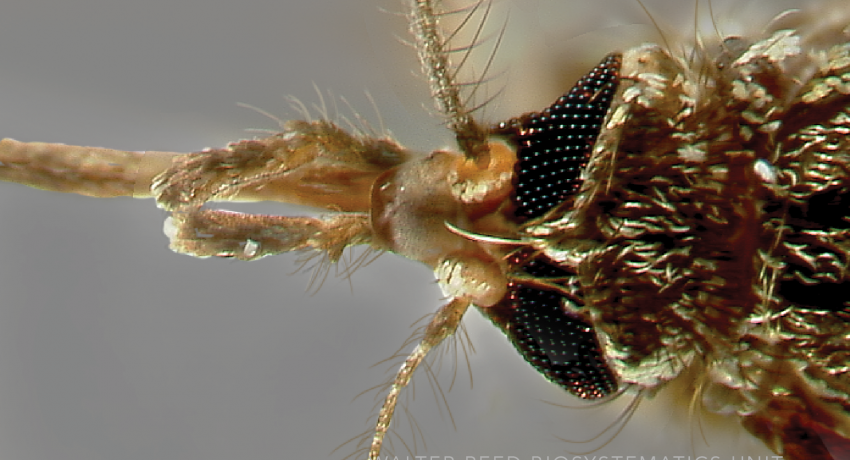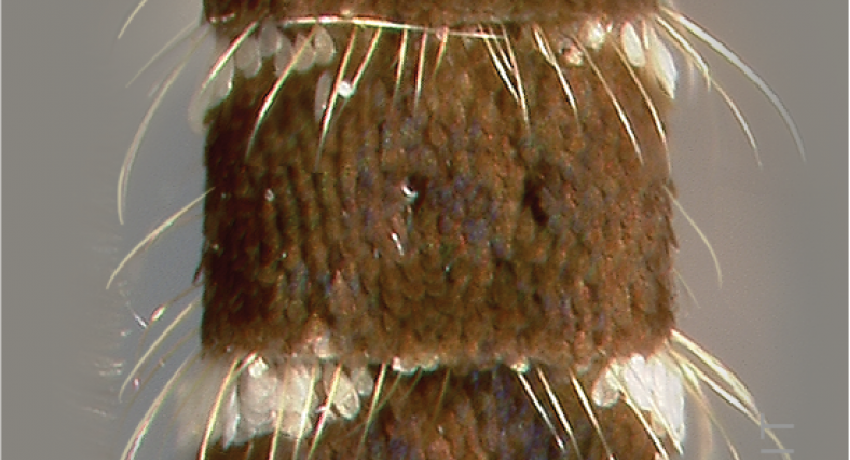ORIENTAL & PALEARCTIC REGIONS
[Nearctic invasive]
Etymology: Togo [Togolese Republic]
Aedes togoi, native to the Palaearctic and Oriental Regions, invaded and became established in the northwestern United States and British Columbia, Canada in the 1960s, most probably transported as desiccated eggs in the used tire trade. Aedes togoi is placed in the newly defined Aedes subgenus Tanakius, along with the Japanese endemic Ae. savoryi Bohart. As adults, Tanakius species are morphologically similar to those in the subgenus Collessius, but they lack the narrow yellowish stripe of scales on the anterior surface of Fe-II, characteristic of Collessius species, and bear a lower mesepimeral seta. Conflicting bionomic reports of Ae. togoi (see below) may be indicative of further cryptic taxa in the subgenus Tanakius.
Type locality: Osaka [Honshu], Japan
Type depository: Natural History Museum, London, England, United Kingdom (NHMUK)
DIAGNOSTIC CHARACTERS (Click photos to view; mouse over and click large photo to zoom in.)
ADULT (illustrated): Head: Palpus with white scales at apex; vertex covered with erect scales, decumbent scales mostly narrow. Thorax: Occiput covered with erect scales; lower mesepimeral seta present; acrostichal and dorsocentral areas with distinct narrow lines of pale scales. Abdomen: VII-Te compressed laterally VIII-Te wide, only semi-retracted into segment VII; cercus short, broad. Wing: Upper calypter with fringe of long setae; alula with narrow marginal scales. Legs: Fe-I–III without pale bands; Fe-II with narrow anterior stripe of yellowish scales; Ta-III1–5 with basal and apical pale bands.
LARVA (not illustrated): Head: Setae 4–6-C inserted well anterior to seta 7-C; setae 5,6-C with multiple branches, arranged in transverse row. Terminal segments: Comb scales rounded and evenly fringed; seta 1-S inserted on distal 0.25 of siphon; siphon short, at most as long as segment X; pecten with evenly spaced spines, inserted at or below base of seta 1-S; anal papillae shorter than segment X; seta 1-X inserted outside saddle; seta 2-X with ≥5 branches; seta 4-X on grid, with grid shorter than length of segment X.
TAXONOMIC KEYS
La Casse & Yamaguti 1950
Tanaka 2002b
Tanaka 2003b
Darsie & Ward 2005
Rattanarithikul et al. 2010
![]()
WRBU – Aedes – Indomalayan Region – Larva
![]()
WRBU – Aedes – East Palearctic Region – Adult
![]()
WRBU – Aedes – East Palearctic Region – Larva
Exemplar DNA sequences
Ae. togoi COI: AB738293, JQ728038–39, KM497421–23, KT358401–03, LC025658–728.
BIONOMICS
Immatures
Typical immature habitats are Ae. togoi are usually brackish or salt water, yet immatures have been recovered from freshwater sites. Females often oviposit in tidal pools, rock pools, glass, clay and stone pots, and cement containers (including water tanks) near coastal areas; seeming to prefer sites containing conspecific larvae—perhaps a predation defense strategy. Inland, immature Ae. togoi have been found in ground pools, ditches and gutters. In colder parts of its range, Ae. togoi overwinters as larvae, whereas in more tropical regions, the species is active all year round.
Adults
Reports of Ae. togoi bionomics are widely variant, indicative of further hidden diversity. Some populations are autogenous—depositing one batch of eggs without a blood meal—whilst others must feed to stimulate oogenesis. In some coastal towns, females ferociously attack people throughout the day, causing a pest nuisance. Other populations are predominantly zoophilic, feeding on the mammals and birds. Although most common in coastal regions, Ae. togoi has also been collected inland.
DISTRIBUTION NOTES
Cambodia, Canada, Japan, Malaysia, People’s Republic of China (includes Hong Kong), Russia, South Korea, Taiwan, Thailand, United States (continental), Vietnam.

WRBU VECTOR HAZARD REPORTS
None; View other WRBU Vector Hazard Reports
Available GIS Models
None
IMPORTANT REFERENCES (full citations below)
Theobald 1907: 379 (F; as Culicelsa)
Ho 1931: 123 (M*, F)
Bohart & Ingram 1946b: 66 (M*, F, P*, L*; bionomics, distribution, taxonomy)
La Casse & Yamaguti 1950 (M*, F*, P*, L*; keys, bionomics)
Asanuma & Nakagawa 1953: 89 (P*)
Omori & Fujii 1953: 23 (bionomics)
Hara 1957: 61 (F*)
Hara 1957 (F*)
Bullock 1960 (E*)
Mohrig 1967 (F*)
Hinton & Service 1969 (E*)
Ramalingam 1969 (distribution; Malaysia)
Gutsevich et al. 1971: 288 (distribution)
Matsuo et al. 1972: 360 (E*)
Matsuo et al. 1972 (E*)
Moriya et al. 1973 (E*)
Gutsevich et al. 1974: 310 (M*, F, L*)
Matsuo et al. 1974: 187 (E*)
Tanaka et al. 1975c: Tanaka et al. 1975c: 220 (distribution)
Tanaka et al. 1979 (M*, F*, L*; keys, taxonomy, bionomics)
Belton 1980: 625 (distribution; US)
Linley & Chan 1991 (E*)
Gornostaeva 2000: 479 (distribution; Russia)
Tanaka 2002b: 144 (P*; taxonomy, key)
Tanaka 2003b (P; key, taxonomy)
Sames et al. 2004 (distribution; US)
Reinert et al. 2004 (phylogeny, taxonomy; to genus Tanakaius)
Darsie & Ward 2005 (F*, L*; keys, distribution)
Reinert 2008i: Fig. 1 (F*)
Sames et al. 2008 (review)
Rattanarithikul et al. 2010 (F*, L*; keys, bionomics, distribution; Thailand)
Wilkerson et al. 2015 (phylogeny, taxonomy; to Aedes subgenus Tanakaius)
CURRENT SYNONYMS
None
CITED REFERENCES
Asanuma, K., & Nakagawa, H. (1953). Morphological and taxonomic studies of some mosquito pupae belonging to the genera Aedes and Culex from Japan, with special regards to the chaetotaxy. Miscellaneous Reports of the Research Institute for Natural Resources, 86–98.
Belton, P. (1980). The first record of Aedes togoi (Theo.) in the United States—aboriginal or ferry passenger? Mosquito News, 40(4), 624–626.
Bohart, R.M., & Ingram, R.L. (1946b). Mosquitoes of Okinawa and islands in the Central Pacific. In United States NAVMED (Bureau of Medicine and Surgery, Navy Department) (pp. 110). Washington.
Bullock, H.R. (1960). Chorionic pattern of Aedes eggs by SUMP method. Transactions of the American Microscopical Society, 79(2), 167–170.
Darsie, R.F., Jr., & Ward, R.A. (2005). Identification and geographical distribution of the mosquitoes of North America, north of Mexico. Gainesville, FL: University Press of Florida.
Gornostaeva, R.M. (2000). A revised checklist of the mosquitoes (Diptera, Culicidae) of European Russia [English translation]. Parazitologiya (St. Petersburg), 34(6), 477–485.
Gutsevich, A.V., Monchadskii, A.S., & Shtakel’berg, A.A. (1974). Fauna of the USSR. New series No. 100 Diptera. Vol. III, No. 4. Mosquitoes. Family Culicidae. Jerusalem, Israel: Keter Publishing House Jerusalem Ltd. (Original work published 1971).
Gutsevich, A.V., Monchadsky, A.S., & Stackelberg, A.A. (1971). Fauna U.S.S.R. New Series No. 100. Diptera. Volume III No. 4 Mosquitoes Family Culicidae [In Russian]. Leningrad: Zoologicheskogo Insitituta Akademii Nauk SSSR. 384pp.
Hara, J. (1957). Studies on the female terminalia of Japanese mosquitoes. Japanese Journal of Experimental Medicine, 27, 45–91.
Hinton, H.E., & Service, M.W. (1969). The surface structure of Aedine eggs as seen with the scanning electron microscope. Annals of Tropical Medicine and Parasitology, 63(4), 409–411.
Ho, C. (1931). Study of the adult culicids of Peiping. Bulletin of the Fan Memorial Institute of Biology, 2, 107–175.
La Casse, W.J., & Yamaguti, S. (1950). Mosquito fauna of Japan and Korea. Office of the Surgeon General, Headquarters, 8th Army, APO 343. United States. 207th Malaria Survey Detachment.
Linley, J.R., & Chan, K.L. (1991). Scanning electron microscopy of the eggs of Aedes togoi and Tripteroides bambusa (Diptera: Culicidae). Tropical Biomedicine, 8(1), 39–47.
Matsuo, K., Yoshida, Y., & Kunou, I. (1972). The scanning electron microscopy of mosquitoes (Diptera: Culicidae). I. The egg surfaces of five species of Aedes and Armigeres subalbatus. Journal of the Kyoto Prefectural University of Medicine, 81, 358–363.
Matsuo, K., Yoshida, Y., & Lien, J.-C. (1974). Scanning electron microscopy of mosquitoes. II. The egg surface structure of 13 species of Aedes from Taiwan. Journal of Medical Entomology, 11, 179–188.
Mohrig, W. (1967). Die taxonomische Bedeutung der Struktur weiblicher Genitalien im Culiciden- Tribus Aedini. Angewandte Parasitologie, 8, 67–100.
Moriya, K., Yabe, T., & Harada, F. (1973). Chorionic markings of some aedine mosquitoes in Japan. 1. Preliminary observations by a scanning electron microscope and a reflected lighting microscope. Japanese Journal of Sanitary Zoology, 24(1), 47–55.
Omori, N., & Fujii, S. (1953). On the feeding habits of Aedes togoi and some other species of mosquitoes. Yokohama Medical Bulletin, 4, 23–31.
Ramalingam, S. (1969). New record of Aedes (Finlaya) togoi (Theobald) in West Malaysia. Medical Journal of Malaya, 23, 288–292.
Rattanarithikul, R., Harbach, R.E., Harrison, B.A., Panthusiri, P., Coleman, R.E., & Richardson, J.H. (2010). Illustrated keys to the mosquitoes of Thailand VI. Tribe Aedini. Southeast Asian Journal of Tropical Medicine and Public Health, 41(1), 1–225.
Reinert, J.F. (2008i). Comparative anatomy of the female genitalia of generic-level taxa in tibe Aedini (Diptera: Culicidae). Part XXIII. Genus Tanakaius Reinert, Harbach and Kitching. Contributions of the American Entomological Institute, 35(4), 1–9.
Reinert, J.F., Harbach, R.E., & Kitching, I.J. (2004). Phylogeny and classification of Aedini (Diptera: Culicidae), based on morphological characters of all life stages. Zoological Journal of the Linnean Society, 142, 289–368.
Sames, W. J., Herman, W. E., Florin, D. A., & Maloney, F. A. (2004). Distribution of Ochlerotatus togoi along the Pacific Coast of Washington. Journal of the American Mosquito Control Association, 20(2), 105–109.
Sames, W. J., Kim, H. C., Chong, S. T., Harrison, B.A., Lee, W. J., Rueda, L. M., & Klein, T. A. (2008). Anopheles lindesayi japonicus Yamada (Diptera, Culicidae) in Korea: comprehensive review, new collection records and description of larval habitats. Journal of Vector Ecology, 33(1), 99–106.
Shamrai, A.F., & Gutsevich, A.V. (1974). Discovery of the mosquito Toxorhynchites christophi new record (Diptera,) in the Khabarovsk Krai USSR with a description of the male. Entomologicheskoe Obozrenie, 53(2), 427–428.
Tanaka, K. (2002b). Studies on the pupal mosquitoes of Japan. (6) Aedes (Finlaya) (Diptera, Culicidae). Japanese Journal of Systematic Entomology, 8(2), 137–177.
Tanaka, K. (2003b). Studies on the pupal mosquitoes of Japan. (8) A key to species of the genus Aedes. Medical and Veterinary Zoology, 54(1), 105–111.
Tanaka, K., Mizusawa, K., & Saugstad, E.S. (1979). A revision of the adult and larval mosquitoes of Japan (including the Ryukyu Archipelago and Ogasawara Islands) and Korea (Diptera: Culicidae). Contributions of the American Entomological Institute, 16, 1–987.
Tanaka, K., Saugstad, E.S., & Mizusawa, K. (1975c). Mosquitoes of the Ryukyu Archipelago (Diptera: Culicidae). Mosquito Systematics, 7(3), 207–233.
Theobald, F.V. (1907). A monograph of the Culicidae of the world (Vol. IV). London.
Wilkerson, R.C., Linton, Y.-M., Fonseca, D., Schultz, T., Price, D., & Strickman, D. (2015). Making mosquito taxonomy useful: A stable classification of tribe Aedini that balances utility with current knowledge of evolutionary relationships. PLoS ONE, 10(7), e0133602.
CITE THIS PAGE
Walter Reed Biosystematics Unit (Year). Aedes togoi species page. Walter Reed Biosystematics Unit Website, http://wrbu.si.edu/vectorspecies/mosquitoes/togoi, accessed on [date (e.g. 03 February 2020) when you last viewed the site].












































































































































































